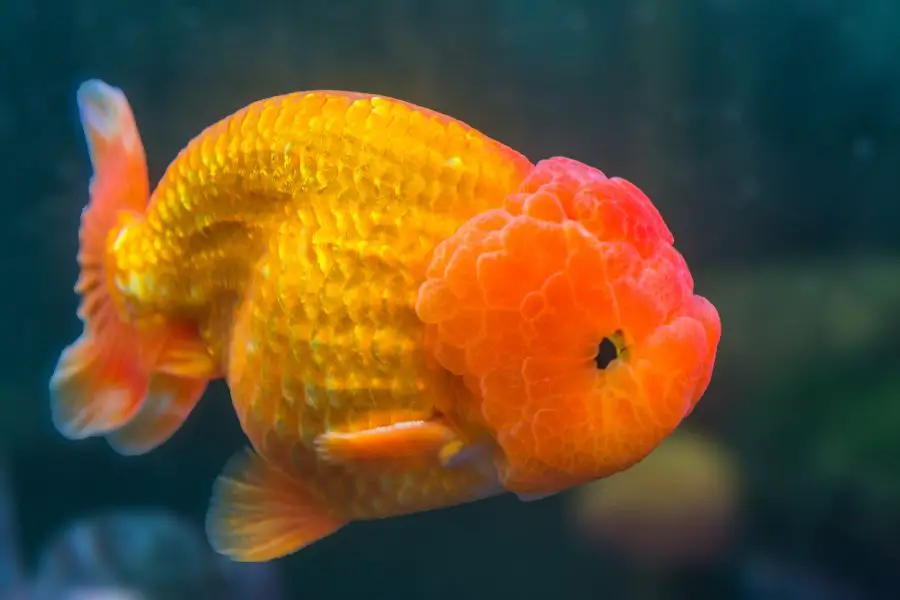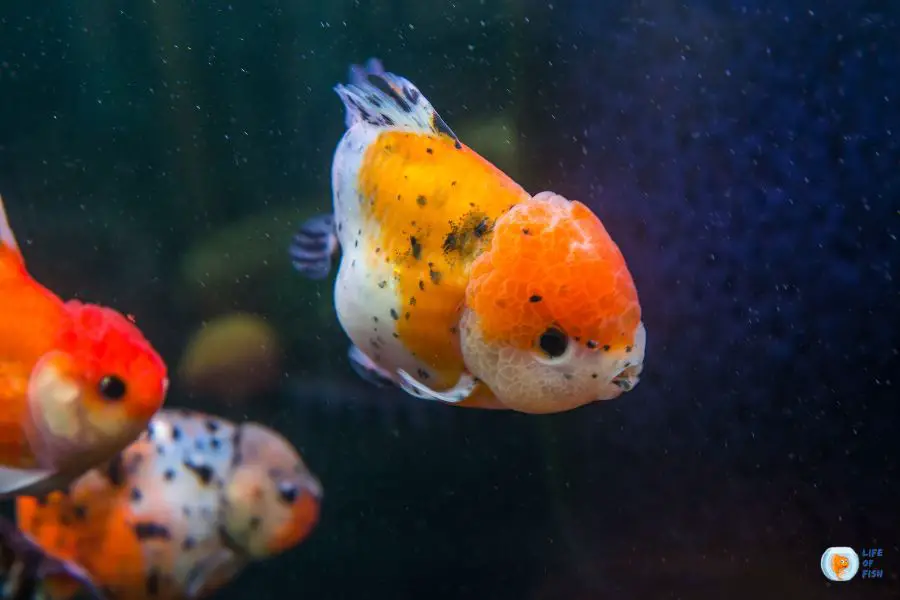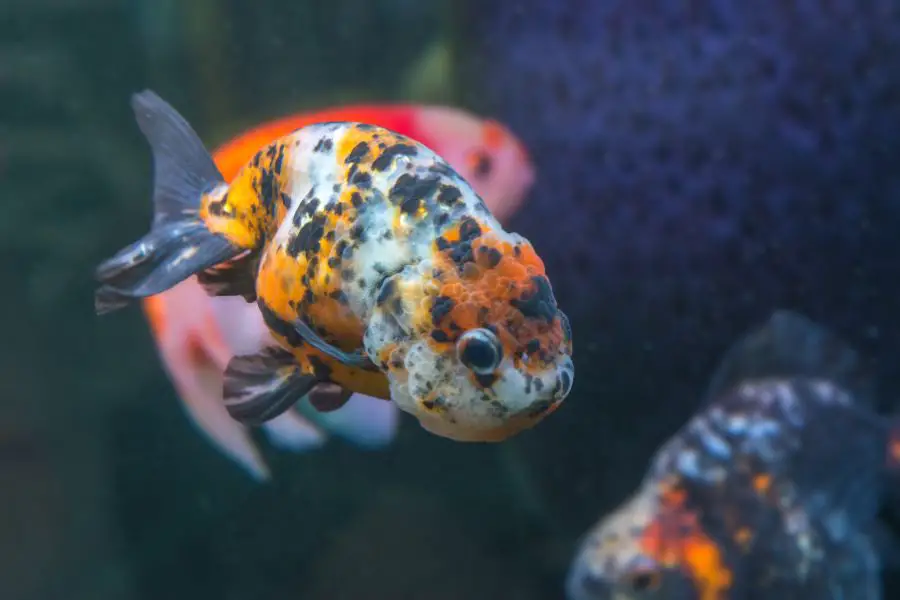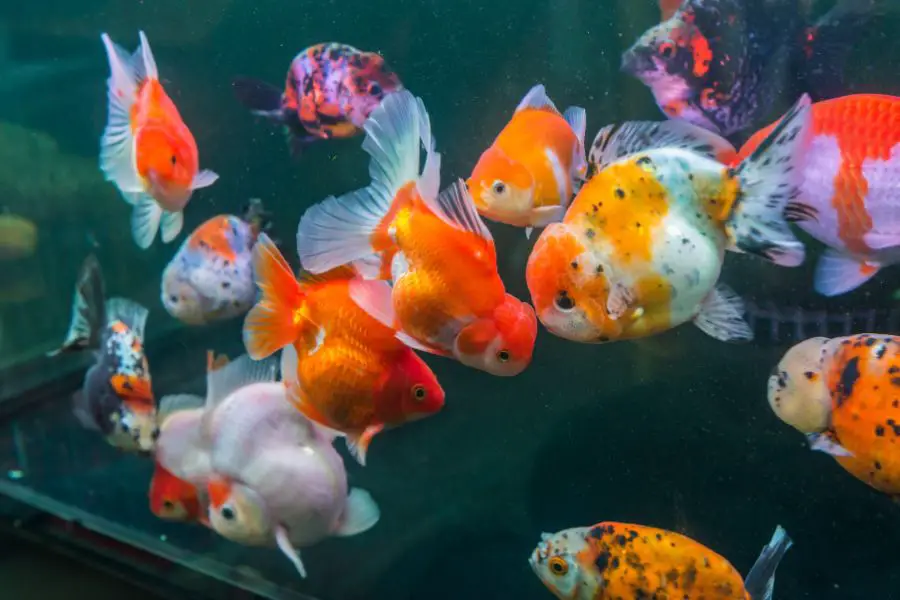With their unique body shape, bubbly eyes, and laidback personality, ranchu goldfish have become a staple in home aquariums. Their charming looks and peaceful nature make them a joy to keep.

But caring for these modified fancy goldfish does come with some specific requirements to keep them healthy long-term. Ranchus need ample space, robust filtration, pristine water quality, and a diet tailored to their anatomy.
Follow this ranchu goldfish care advice to enjoy their companionship in your freshwater aquarium!
An Introduction to Ranchu Goldfish
Jump To
- 1 An Introduction to Ranchu Goldfish
- 2 Providing the Proper Ranchu Goldfish Tank Setup
- 3 Caring for Your Ranchu Goldfish’s Water Quality
- 4 Ranchu Goldfish Diet & Proper Feeding Techniques
- 5 Compatible Ranchu Goldfish Tankmates
- 6 Ranchu Goldfish Behavior & Personality
- 7 Typical Ranchu Lifespan & Health Concerns
- 8 Breeding & Raising Ranchu Goldfish Fry
Ranchus are a breed of fancy goldfish that originated in Japan in the early 1800s from mutations of wild Prussian carp. Their trademark features include:
- Egg-shaped body lacking a dorsal fin
- Head growths called wen
- Upward pointing eyes with bubbly appearance
- Vibrant reddish-orange coloration
Due to their anatomical deformities, ranchus are not strong swimmers like common goldfish. But what they lack in mobility, they make up for in personality!
Some quick ranchu goldfish facts:
- Adult Size: 6-10 inches long
- Normal Lifespan: 10-20 years with proper care
- Water Temperature: 65-75°F
- pH: 6.5-8.0
- Care Level: Moderate – requires specific setup
- Temperament: Peaceful, slow-moving
- Diet: Omnivore – flakes, pellets, veggies
Now that you know a bit about their background, let’s dive into their habitat and tank requirements.

Providing the Proper Ranchu Goldfish Tank Setup
Since they are handicapped swimmers, ranchus need an aquarium optimized for their physical traits. Here are the ideal tank conditions:
Minimum Tank Size
Due to their large size and heavy waste output, start with at least a 40 gallon breeder tank for 1-2 ranchus. Go bigger if adding more fish.
Substrate & Decor
Bare bottom tanks or very fine sand allow waste to be removed versus getting trapped. Decor should be smooth without abrasive edges or sharp points.
Filtration & Circulation
Use a strong external canister filter rated for at least double the tank volume to keep water pristine. Strategically angle powerheads to create a gentle circular flow ranchus can swim in.
Water Parameters
Provide cool, alkaline freshwater between 65-72°F. pH in the 7.0-8.0 range is ideal. Perform 30-40% weekly water changes and test parameters routinely.
Aeration & Surface Agitation
Ranchus have high oxygen needs. Supplement the tank with air stones or air-driven sponge filters. Allow for gas exchange via hang-on-back filters or powerheads breaking the surface.
Now that we’ve covered the critical setup needs, let’s go over the water maintenance required to keep ranchus healthy.
Caring for Your Ranchu Goldfish’s Water Quality
Given their anatomical issues, ranchus are extremely sensitive to water quality. Staying on top of maintenance is key to their health.
Nitrogen Cycling
Fully cycle the tank before adding ranchus to build up beneficial bacteria that convert ammonia and nitrite into less toxic nitrate. Add an ammonia source to feed the nitrogen cycle.
Test water parameters until ammonia and nitrite show zero ppm and nitrates measure above zero before adding fish.
Weekly Water Changes
Perform 30-40% partial water changes weekly, or up to 50% changes biweekly, using a gravel vacuum to remove solid waste. Monitor ammonia, nitrites, and nitrates and change water if any climb.
Chemical Filtration
Filtering water through activated carbon or other chemical media helps absorb dissolved wastes missed by biological filtration alone. Replace as directed.
Water Testing
Test pH weekly and total water hardness monthly to ensure parameters are in the ideal range for ranchus. Adjust as needed with buffers, shell grit or RO water.
Cleaning & Maintenance
Wipe down tank walls to remove algae buildup. Clean filters monthly to remove gunk and maintain optimal flow.Trim plants to prevent overgrowth.
With ideal water conditions covered, let’s look at the diet and feeding methods ranchu goldfish require.

Ranchu Goldfish Diet & Proper Feeding Techniques
Ranchus have unique dietary needs due to their physical form. Here are some feeding best practices:
- Offer a high-quality sinking pellet as their staple food, feeding what they can eat within 2 minutes 1-2x daily.
- Supplement with blanched veggies like zucchini, peas, spinach to aid digestion a few times per week. Chop finely or blend these.
- Feed a variety of freeze dried treats like bloodworms, brine shrimp, daphnia and tubifex worms 1-2x weekly for enrichment.
- Let foods soften before feeding. Ranchus may have difficulty eating dried items due to wen growth and upward facing eyes.
- Position food to sink right in front of your ranchu’s face so it can easily find and consume it.
- Fast 1 day per week to support health.
By tailoring their diet and carefully feeding, you can keep your ranchu goldfish nourished and healthy!
Compatible Ranchu Goldfish Tankmates
Given their slow speed and peaceful nature, ranchus pair best with similar species that won’t compete for food:
Good Tankmates
- Other calm fancy goldfish like black moors, orandas, ryukins, etc.
- Bottom-dwellers like loaches and plecos that won’t nip flowing fins
- Snails like nerites and mystery snails that clean algae
Questionable Tankmates
- Shrimp may get eaten or harassed
- Smaller fish like tetras that can steal food
- Common goldfish and shubunkins that easily outcompete
Bad Tankmates
- Large aggressive species that may see them as prey
- Fast robust fish that further limit food access
- Known fin nippers like barbs, danios and cichlids
- Crayfish, crabs and turtles that may harm them
Research any additions fully before introducing to ensure compatibility. Provide sinking foods to give ranchus a fair chance at meals.
Now that we’ve covered care basics let’s discuss typical ranchu behavior and personality!
Ranchu Goldfish Behavior & Personality
While their anatomy limits speed, ranchus make up for it with charming behaviors and peacefulness:
- Typically slow moving and gentle with tankmates
- Will scavenge along the bottom searching for fallen food
- Love exploring new tank decor added to their environment
- Enjoy resting on or under decor, substrate and plants
- Peaceful and social when grouped with other calm goldfish
- Will interact with owners when approached due to good eyesight
- Relatively hardy once acclimated to tank conditions
- Can tolerate a wide temperature range between 65-80°F
Try hand feeding treats to bond with your ranchu! Their upward facing eyes allow them to spot food above the surface.
Typical Ranchu Lifespan & Health Concerns
With pristine water quality and a good diet, ranchus can exceed 15-20 years in home aquariums! Maximize their lifespan by:
- Performing frequent water testing and changes
- Removing uneaten food promptly
- Avoiding sharp decor that can tear fins
- Keeping water temperature cool, under 75°F
- Quarantining new arrivals for 4+ weeks
Some common health issues ranchus can face include:
- Swim bladder disorder
- Eye infections due to wen impingement
- Fungal or bacterial fin and tail rot
- Parasites like flukes, ick, and anchor worm
- Constipation and indigestion from poor diet
Catch issues early by knowing your fish’s normal behavior and closely observing them daily. Maintain immaculate water quality and feed a varied diet to keep ranchus thriving for years on end!

Breeding & Raising Ranchu Goldfish Fry
While complex, breeding ranchu goldfish is possible if desired:
- Condition adults for 2-3 weeks by feeding live foods like brine shrimp
- Use a 20 gallon spawning tank with Marbles or plants
- Ideal parameters are 70°F, pH 7.5-8.0, very soft water less than 4 dGH
- Males will bump and nudge females, stimulating egg release
- Eggs stick to surfaces – remove adults
Bubble Eye – The Goldfish With Big Cheeks
Baby Black Moor Goldfish | Everything You Need To Know |
